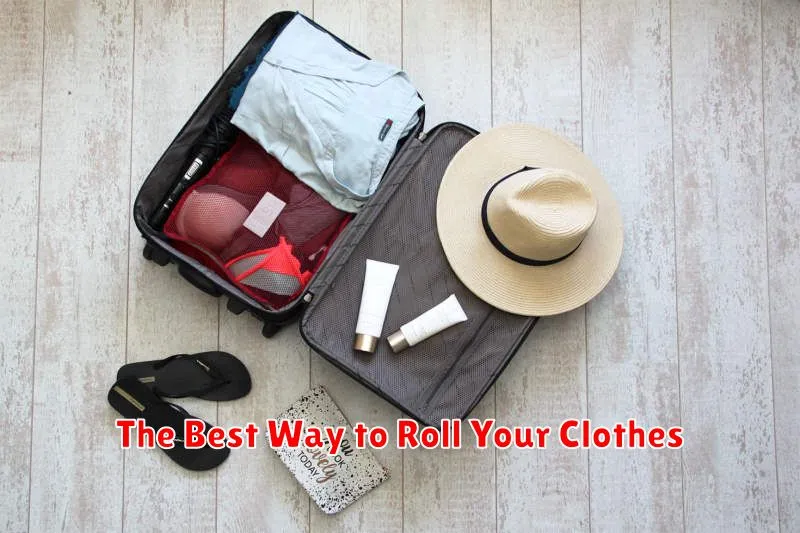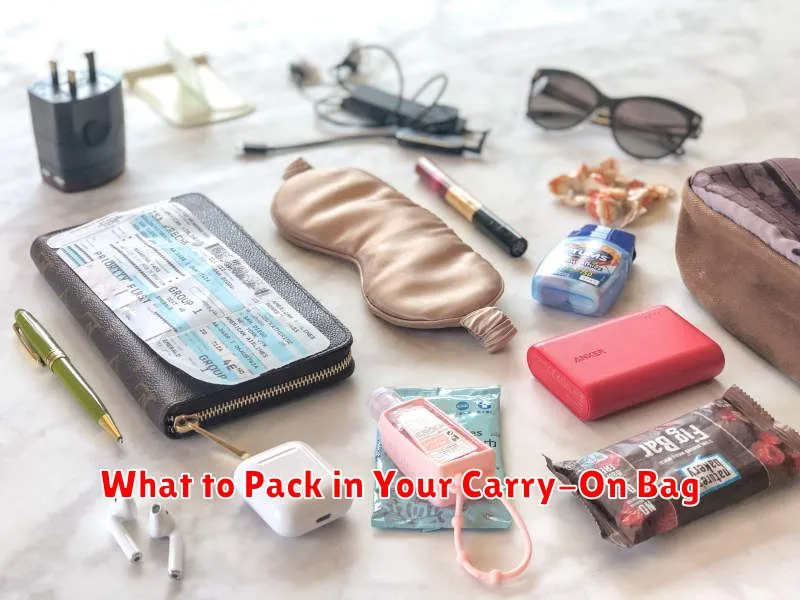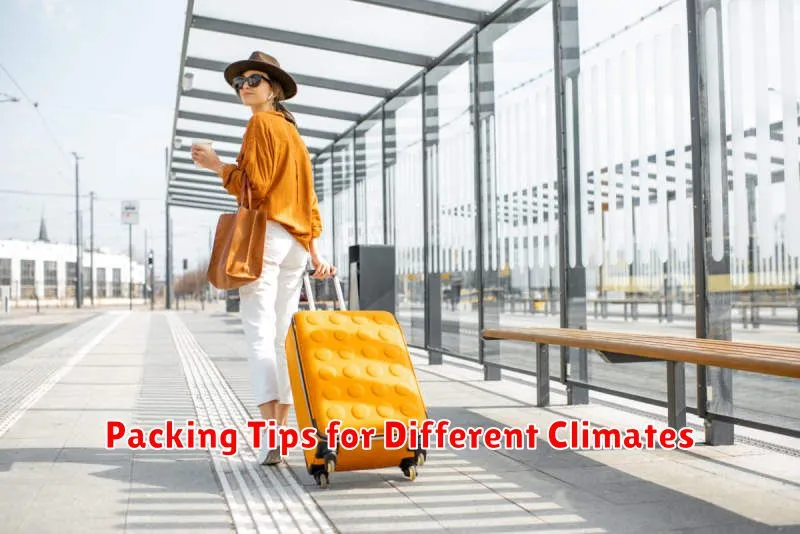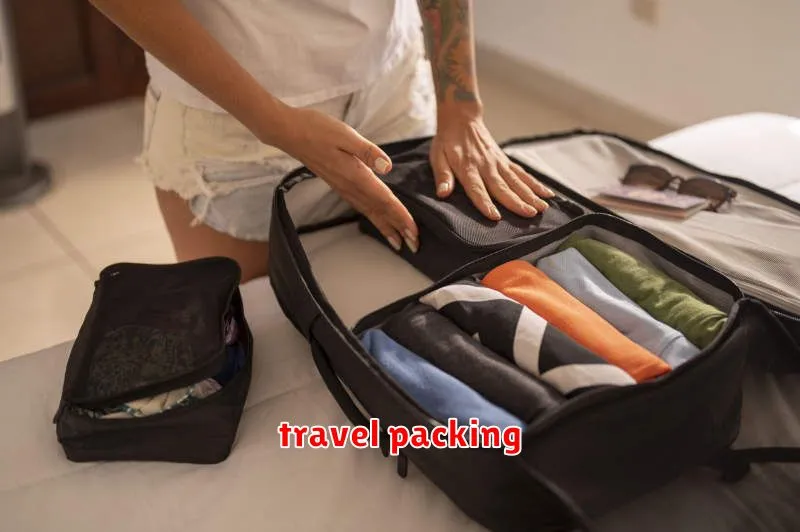So you’re planning a trip, whether it’s a weekend getaway or an extended backpacking adventure? Packing can feel like a daunting task, but it doesn’t have to be! Mastering the art of packing like a pro can transform your travel experience, ensuring you have everything you need while avoiding that dreaded overweight baggage fee. This comprehensive guide, “How to Pack Like a Pro for Any Trip,” will equip you with essential packing tips and tricks, covering everything from choosing the right luggage to utilizing space-saving techniques. Learn how to create a perfectly organized packing list tailored to your specific trip, so you can focus on enjoying your adventure rather than stressing over your suitcase!
The Best Way to Roll Your Clothes

Rolling your clothes is a far superior packing method to folding, especially when space is at a premium. It minimizes wrinkles and maximizes space within your luggage. Rolling compresses your garments, reducing the overall volume significantly compared to traditional folding.
To roll effectively, lay your garment flat. Start at one end, smoothing out any wrinkles. Tightly roll the item inwards, like a burrito, ensuring a firm and compact cylinder. Secure smaller items with a rubber band if needed to maintain their shape.
Consider the fabric: Delicate fabrics like silk or linen may require a more gentle rolling approach to avoid creasing. Thicker materials like jeans and sweaters can be rolled more tightly.
This method works well for most clothing items – shirts, pants, underwear, and even some dresses. Experiment to find the best rolling technique for different types of clothing to maximize packing efficiency and minimize wrinkles.
How to Choose the Right Luggage
Choosing the right luggage is crucial for a smooth and enjoyable trip. The type of luggage you need depends heavily on the duration and type of your trip.
For short trips (weekends or a few days), a carry-on suitcase or a duffel bag is often sufficient. Consider a rolling carry-on for ease of transport, especially if you’ll be navigating airports or train stations. For longer trips, a larger checked suitcase will be necessary. Think about the size and weight restrictions of your chosen airline.
Material is another key consideration. Hard-shell luggage offers excellent protection against bumps and scratches, while soft-shell luggage tends to be more flexible and often lighter. Consider the climate you’ll be traveling in; a hard shell might be better for protecting fragile items, but a soft shell might be more convenient if you need to squeeze in extra items.
Finally, consider the features. Look for features like spinner wheels for easy maneuverability, TSA-approved locks for security, and external pockets for easy access to essentials. Don’t forget to check for a comfortable handle and sturdy zippers.
By carefully considering these factors, you can choose luggage that’s perfectly suited to your travel needs, making your packing experience much simpler and more efficient.
Essential Packing Hacks for Space Saving
Packing light doesn’t mean sacrificing style or comfort. Mastering these space-saving hacks will transform your packing game.
Roll, don’t fold: Rolling your clothes instead of folding them saves significant space and minimizes wrinkles. This technique is particularly effective for t-shirts, jeans, and trousers.
Utilize compression bags: These handy bags squeeze out excess air, dramatically reducing the volume of your clothes. They’re a lifesaver for bulky items like sweaters and jackets.
Wear your bulkiest items: Instead of packing your heaviest shoes and jacket, wear them on the plane or during travel. This frees up valuable space in your luggage.
Choose versatile clothing: Opt for items that can be mixed and matched to create multiple outfits. Neutral colors and fabrics that don’t wrinkle easily are your best friends.
Leave unnecessary items behind: Be ruthless! Before you pack, critically assess each item. Do you *really* need that extra pair of shoes or that novel you’ve been meaning to read?
Pack strategically: Place heavier items at the bottom of your bag and distribute weight evenly. This prevents your bag from being top-heavy and makes it easier to carry.
Use packing cubes: These are great for organizing your belongings and maximizing space. They compress clothing and help keep your bag tidy.
By implementing these essential packing hacks, you’ll be able to travel lighter, more efficiently, and with less stress, leaving you more time to enjoy your trip.
What to Pack in Your Carry-On Bag

Your carry-on bag is your lifeline during travel, containing essentials you’ll need readily accessible. Prioritize items that are irreplaceable or crucial for comfort during delays or unexpected circumstances.
Documents are paramount: Passport, driver’s license, boarding pass (printed or digital), travel insurance information, and any necessary visas. Keep these readily available in a easily accessible pocket or separate pouch.
Pack essential medications in their original containers with prescriptions, along with any necessary first-aid supplies. Don’t forget your glasses or contact lenses and solution.
For electronics, bring your phone, charger, portable charger, and any essential adapters. Consider a tablet for entertainment, but remember to charge it fully before your trip. A noise-canceling headphones is recommended for a more peaceful flight.
Regarding personal items, pack a small toiletry bag with travel-sized essentials like toothbrush, toothpaste, deodorant, and any skincare products you need. Include a comfortable change of clothes in case of checked baggage delays.
Finally, remember a good book, a magazine, or downloaded entertainment for those moments of downtime. Packing strategically with a focus on versatile clothing items and essential items will ensure a smooth and comfortable journey. A reusable water bottle will allow you to stay hydrated throughout your trip, although you may need to empty it at security.
How to Organize Your Travel Documents
Organizing your travel documents is crucial for a stress-free trip. Proper organization ensures you have quick access to essential information and prevents frantic last-minute searches.
Start by making digital copies of all important documents: passport, visa, tickets (flight, train, bus), hotel confirmations, travel insurance policy, and driver’s license. Store these copies in a cloud-based service like Google Drive or Dropbox, and also email them to yourself. This provides backup access if your physical copies are lost or damaged.
For physical documents, consider using a dedicated travel wallet or organizer. This keeps everything together and prevents papers from getting crumpled or lost in your luggage. Alternatively, a large, zip-top bag works well. Clearly label everything for easy identification.
Prioritize important documents by placing frequently needed items, like your boarding pass and passport, in easily accessible pockets. Consider using waterproof cases to protect against spills or rain.
Finally, create a packing list and check off items as you pack them. This prevents forgetting crucial documents and helps streamline the packing process. Remember to keep a physical copy separate from your digital copies, preferably in a different bag.
Packing Tips for Different Climates

Packing for various climates requires a strategic approach. Consider the forecast meticulously before you begin. Check for average temperatures, potential rainfall, and wind conditions. This will inform your clothing choices.
For hot and humid climates, prioritize lightweight, breathable fabrics like linen and cotton. Pack loose-fitting clothing, and don’t forget essentials like a wide-brimmed hat, sunglasses, and high SPF sunscreen. Consider quick-drying clothing to manage sweat.
In cold climates, layering is key. Pack thermal underwear as a base layer, followed by fleece or wool mid-layers, and a waterproof outer shell. Don’t forget warm socks, a hat, gloves, and a scarf. Choose water-resistant boots for optimal protection.
For temperate climates, you’ll need a mix of clothing options. Pack layers that can be easily added or removed depending on the temperature fluctuations throughout the day. A light jacket or sweater is a must-have, along with comfortable walking shoes.
Remember to always pack versatile clothing items that can be mixed and matched to create multiple outfits, minimizing the overall quantity you need to carry. Efficient packing saves space and weight in your luggage.
Finally, always check the specific packing restrictions of your airline or mode of transportation before you leave. This ensures a smooth and stress-free journey.
What to Leave at Home to Save Space
Packing light is key to stress-free travel. To maximize your space and minimize your baggage, consider leaving behind these often unnecessary items:
Books: Download ebooks onto your tablet or phone instead. They’re lighter and you can carry a whole library!
Too Many Shoes: Choose versatile footwear that can be worn for multiple occasions. Limit yourself to two or three pairs at most, depending on your trip length and activities.
Excess Toiletries: Travel-sized containers are your friend. Many hotels provide basic toiletries, so only pack what you absolutely need. Check airline regulations regarding liquids before you go.
Unnecessary Electronics: Do you really need both your tablet and your laptop? Consider consolidating. Leave behind bulky chargers and extra cables unless they’re absolutely essential.
Multiple Outfits for Each Day: Choose versatile clothing items that can be mixed and matched. Focus on neutral colors that can be combined easily. Pack only what you realistically need, remembering you can do laundry along the way.
Large or Bulky Items: Avoid oversized items that will take up valuable space. Consider whether you really need that bulky sweater or that extra pair of jeans. Before you pack, lay everything out on your bed and carefully assess each item.
By strategically eliminating these items, you’ll create more space in your luggage and have a much more enjoyable travel experience. Remember to always check the weather forecast and pack accordingly!
The Importance of a Packing Checklist
Creating a packing checklist is paramount for stress-free travel. It’s the cornerstone of packing like a pro, transforming a potentially chaotic experience into an organized and efficient one.
Time Savings: A checklist drastically reduces packing time. Instead of frantically searching for items, you simply check them off your list, ensuring nothing is forgotten.
Prevents Overpacking: Overpacking is a common problem. A checklist allows you to thoughtfully consider each item’s necessity, preventing you from lugging around unnecessary baggage.
Reduces Stress: Knowing you have everything you need eliminates pre-trip anxiety. You can relax and focus on enjoying the anticipation of your journey, instead of worrying about forgotten essentials.
Enhances Organization: A well-structured checklist helps you pack efficiently, ensuring easy access to items during your trip. This is particularly beneficial for longer vacations.
Promotes Efficiency: A checklist streamlines the entire packing process, allowing you to focus on other important pre-trip preparations. This means less time spent packing and more time spent planning your adventures.
In short, a packing checklist isn’t just a helpful tool; it’s an essential strategy for anyone looking to master the art of packing and embark on a smooth, enjoyable trip. It’s the first step to becoming a packing pro.
How to Secure Your Belongings While Traveling
Traveling can be stressful, especially when worrying about your belongings. Security is paramount, so taking proactive steps is crucial. Here’s how to keep your valuables safe:
Carry-on essentials: Keep your passport, phone, wallet, and other vital items on your person or in a secure, crossbody bag worn under your clothing. Avoid displaying expensive jewelry or electronics openly.
Checked luggage protection: Use strong, durable luggage with TSA-approved locks. Consider a luggage tracker for peace of mind. Pack valuables in your carry-on; avoid placing anything irreplaceable in checked bags.
Hotel room safety: Use the in-room safe for valuable items like jewelry and electronics. Keep your room door locked, even when you are inside. Be mindful of who you let into your room.
Travel insurance: Travel insurance can provide coverage for lost or stolen belongings, offering financial protection against unforeseen circumstances. Always review your policy before your trip.
Awareness is key: Stay vigilant in crowded areas, and be aware of your surroundings. Avoid displaying large amounts of cash. Trust your instincts – if a situation feels unsafe, remove yourself.
By following these simple steps, you can significantly reduce the risk of losing or having your belongings stolen while traveling and enjoy a more relaxing and worry-free trip.
Packing Tips for Long-Term Travel
Long-term travel requires a different packing strategy than a short weekend getaway. The key is to pack light and smartly, minimizing the amount of luggage you carry while maximizing versatility.
Choose versatile clothing: Opt for neutral-colored items that can be mixed and matched. Pack layers to adapt to changing temperatures. Consider items made from quick-drying fabrics to save space and reduce laundry needs.
Roll, don’t fold: Rolling your clothes saves space and minimizes wrinkles. This technique is particularly useful for long journeys.
Limit shoes: Shoes take up a lot of space. Choose 2-3 pairs maximum, prioritizing comfort and versatility. Consider shoes that can be worn for both casual and slightly dressier occasions.
Pack light toiletries: Utilize travel-sized containers or buy essentials at your destination to save weight and space. Consider solid toiletries like shampoo bars to reduce liquid volume.
Utilize packing cubes: These are game-changers for organized packing. They compress your belongings and help you separate different items.
Leave space: Don’t pack your bag to the brim. You’ll likely acquire souvenirs and other items during your travels. Leaving some space allows for flexibility.
Consider a backpack: A well-designed backpack allows for better weight distribution compared to a suitcase, making long-term travel more comfortable.
Prioritize essentials: Before packing, make a list of absolutely necessary items. This helps you avoid overpacking.

